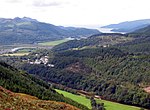Rhobell Fawr
Brithdir and LlanfachrethHewitts of WalesMarilyns of WalesMountains and hills of GwyneddMountains and hills of Snowdonia ... and 4 more
NuttallsOrdovician volcanoesPages with Welsh IPAVolcanoes of Wales

Rhobell Fawr is the site of an ancient volcano that was active during the Early Ordovician period in the Arenig range within the Snowdonia National Park. Despite its modest height of 734 m (2,408 feet), it is a mountain with views of higher peaks all around, including the north face of Cadair Idris and distant Snowdon. The paths are not well trodden, but there is a distinct path up from Bwlch Goriwared, a couple of miles north-north-east of the small village of Llanfachreth.
Excerpt from the Wikipedia article Rhobell Fawr (License: CC BY-SA 3.0, Authors, Images).Rhobell Fawr
Pont ar Felau,
Geographical coordinates (GPS) Address Nearby Places Show on map
Geographical coordinates (GPS)
| Latitude | Longitude |
|---|---|
| N 52.814 ° | E -3.802 ° |
Address
Pont ar Felau
LL40 2BU , Brithdir and Llanfachreth
Wales, United Kingdom
Open on Google Maps










